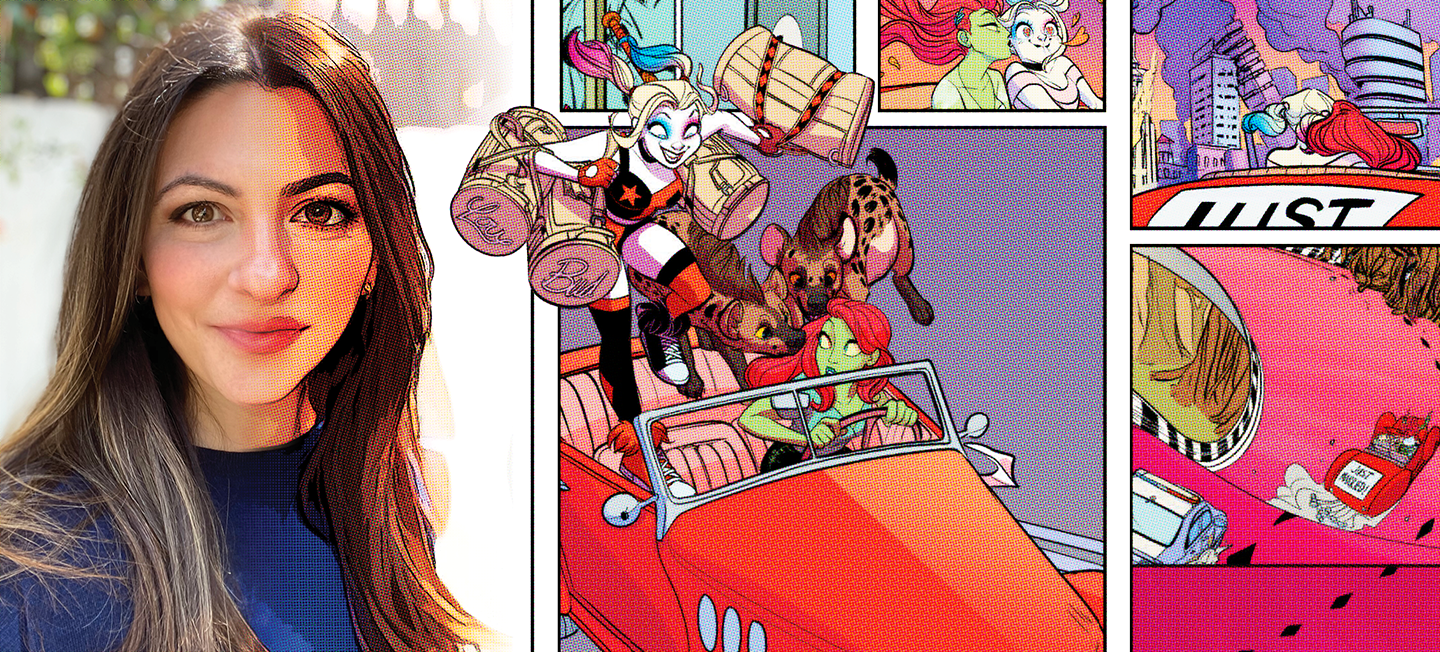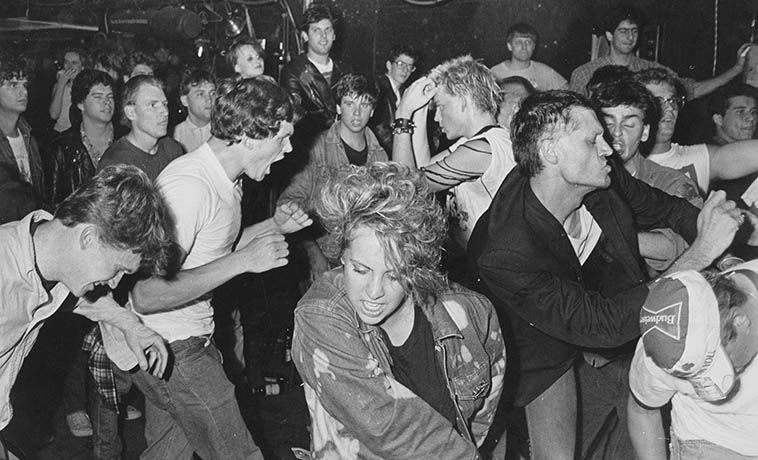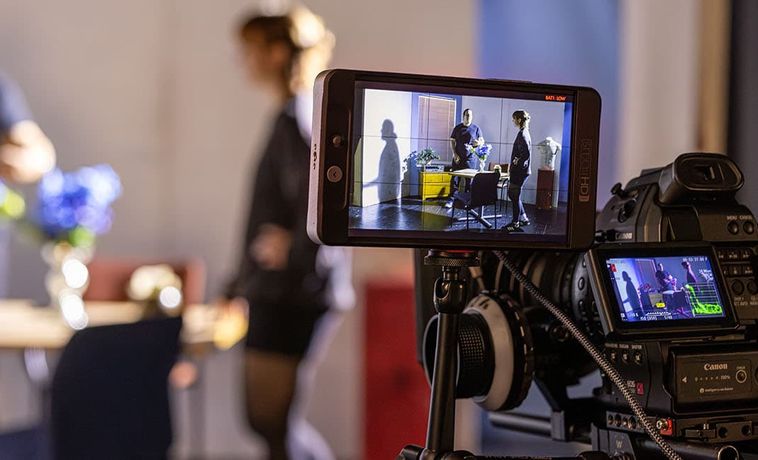Superheroes Run in the Family
Katie Kubert, a third-generation comic book creator, has guided the adventures of Superman, Batgirl and the X-Men

"There are female voices with stories to tell and there are women who want to read those voices and see themselves reflected on the page," says Katie Kubert. Photo illustration by Monica Chu. Images courtesy Katie Kubert and DC Comics.
Katie Kubert avoided the family business for as long as she could. She wanted to find her own path, so she studied film and television at COM, got a job at The Late Show with David Letterman and worked in an art gallery. But Kubert (CGS’04, COM’06) wanted to create art and tell stories and she quickly realized those jobs wouldn’t satisfy those cravings. She knew one that would, at the last place she thought she’d end up: DC Comics.
Kubert, you see, is comic book royalty. Her grandfather, artist Joe Kubert, worked in comics for seven decades, often for DC where he was known for drawing Hawkman and Sgt. Rock. The Kubert School is still training comic artists a decade after his death. Two of his sons—Kubert’s uncles, Andy and Adam—are also industry mainstays, frequently drawing superheroes from across both the DC and Marvel universes.
“I didn’t read their comics growing up. I read Calvin & Hobbes and Life in Hell and things like The Far Side,” Kubert says. “I never really knew their impact in the industry and I never wanted to work in comics.”
Yet in 2009, Kubert accepted a job as prepress coordinator at DC and began working her way up. She’s been in an editorial role since 2011—most of that time at DC, interrupted by a two-year stint at Marvel.
Now Kubert is a senior editor for global publishing innovation, which is a fancy title that means DC has put her in charge of finding new fans. To that end, she has dropped Batman into a popular video game world (Batman/Fortnite: Zero Point), launched a new line of horror comics with titles like Soul Plumber and based another title off a TV series (Harley Quinn: The Animated Series: Eat, Bang! Kill Tour). Harley Quinn was nominated for a 2022 GLAAD Media Award for its representation of the LGBTQ community.
Crafting the Comic Universe
While artists and writers—like Kubert’s grandfather and uncles—get much of the credit for comic book creation, editors carefully guide each project behind the scenes. They think big picture, trying to attract new audiences while pleasing longtime readers. They weave the stories into a broader comic universe and make sure they don’t conflict with decades of prior events. Kubert describes the job as part film director, part film producer.
“You’re shepherding a project from start to finish,” she says. That means casting a writer and artists whose styles with pencil, ink, colors and letters will strike the right tone, then helping them realize their collective vision for the comic. “We want the reader to feel something, to connect with the story—and there are all these subtle ways of doing it,” Kubert says. “And if you’re doing a good job, the reader will never know you did it.”
Comics are all about giving the readers what they expect, but not in the ways that they expect it.
Katie Kubert
At DC, where her grandfather made his name, Kubert sometimes finds herself working on the same characters he once drew. Part of her responsibility is keeping them interesting and relevant to a new generation of readers. It’s like a soap opera, she says, with generations of characters and storylines rotating in and out. Continuity must be maintained, but there’s also a lot of room for writers and artists to maneuver.
“Comics are all about giving the readers what they expect, but not in the ways that they expect it,” she says. That means, for instance, adhering to eight decades of Batman traits and traditions (he doesn’t use guns, for example) while continually finding new ways to present him. “A character will always have their immutable, defining things that you cannot change,” Kubert says. “It’s the situations that you place them in, and the conflicts that they overcome or succumb to, that shape who they are.”
Old Faces, New Readers
One of the first titles that Kubert edited was Batgirl. “I wanted something that resonated with people in a way that previous iterations had not, and I wanted to get more women to connect with the book,” she says. “I wondered, what would a 20-something woman be doing if she lived on her own in New York—like I did? I was watching Girls at the time, so I thought, ‘What if we combined Girls with superheroes?’” The result was a character navigating roommates, clubs, dating apps and, of course, crime fighting.
When Kubert was promoted to senior editor in August 2021, her new team’s mission was clear: “Attract readers outside of the direct market—meaning outside of the comic book store,” she says. “If you’ve never read a comic book before, what is going to make you pick one up?”
There are female voices with stories to tell and there are women who want to read those voices and see themselves reflected on the page.
Katie Kubert
It’s a question comic book publishers have long grappled with. While individual title sales have decreased for decades—the best-selling issue of a comic in modern history was X-Men #1 in 1991, which eclipsed 8 million copies; the first issue of an X-Men reboot in 2019 sold about 250,000—the selection is as diverse as ever. Nearly 50 different titles are expected from DC in April 2022 alone, with dozens more coming from Marvel, Image, Dark Horse and other publishers. There are superheroes, of course, but also horror, sci-fi, romance, comedy and true crime. To comic book novices, Kubert has a simple pitch: “What kind of stories do you like? Because there’s probably a comic that has a similar feel.”
One way that companies have reached new readers is obvious: representing them in the stories, as Kubert did with her version of Batgirl. “There are female voices with stories to tell and there are women who want to read those voices and see themselves reflected on the page,” she says. “I’ve been in comics for 13 years and there’s been a pretty seismic shift in those years.” That shift isn’t just in gender representation. Last year, DC revealed a Black Batman and Superman had a romantic relationship with another another man.
Comic books also allow creators to take more whimsical liberties with characters. Kubert mentions a mashup of Porky Pig and supervillain Lex Luthor as a personal favorite. And one of her next titles, due out May 10, is Jurassic League. The play on DC’s classic Justice League reimagines Batman as an Allosaurus, Wonder Woman as a Triceratops and Superman as a Brachiosaurus. It’s a dream project for Kubert, a self-professed dinosaur nerd who excavates fossils in a lab at the Natural History Museum of Los Angeles County in her spare time.
Kubert can’t say what DC has planned beyond Jurassic League, but she’s excited about continuing to please and surprise readers. “I came to comics because it was such a good combination of all the things I loved,” she says. “It’s a way to be a storyteller and to help make something with some of the most prolific voices and talent out there.” And, even though it took her a while to realize that, she’s now poised to carry the family tradition into its ninth decade.


